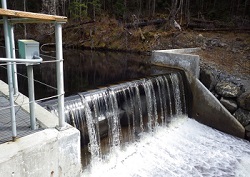Hydroelectric Projects
Overview

Many hydroelectric projects require a Fish Habitat Permit from the Habitat Section. Our permitting authority for hydroelectric projects is focused on protecting fish and their habitats during construction and operation and maintaining fish passage in all fish-bearing waterbodies. The ADF&G plays an important role in assisting the applicant in the design of study plans for collecting data on fish, wildlife, and water resources in the project area. Activities related to installation and operation of a hydroelectric project which may require a Fish Habitat Permit include:
- Construction of access roads with stream crossings requiring bridges or culverts;
- Temporary or permanent water withdrawal from lakes and streams;
- Construction of diversion structures, dams, and water intake structures;
- Construction of powerhouse facilities;
- Installation of turbines or waterwheels in fish bearing streams; and
- Alteration or interruption of water flow which may affect fish habitat.
In addition to Fish Habitat Permits, most hydroelectric projects require authorization from other state and federal agencies including the Alaska Department of Natural Resources and the U.S. Army Corps of Engineers.
FERC Licensing
Most large hydroelectric projects in Alaska are licensed by the Federal Energy Regulatory Commision (FERC). FERC licenses determine how to allocate river flows between energy generation and other beneficial uses recognized by the Federal Power Act (FPA) as well as other applicable laws. As the state fish and wildlife agency, the FPA affords considerable weight and due deference to the ADF&G. The ADF&G participates in the entire FERC licensing process and National Environmental Policy Act (NEPA) review. The department's Instream Flow Program is responsible for providing comments and technical expertise to FERC and the project applicant
